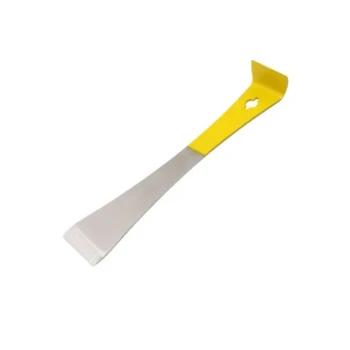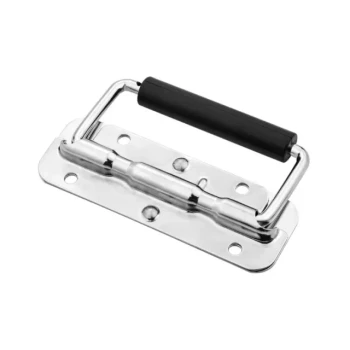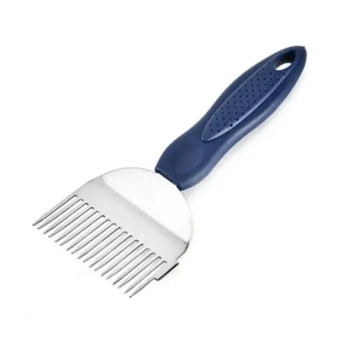A beekeeper's role in hive relocation is one of careful planning and precise execution. The beekeeper is solely responsible for every critical phase: preparing the hive for transit, ensuring adequate ventilation to prevent overheating, physically moving the colony with minimal stress, and managing the bees' reorientation at the new site to prevent them from returning to the old one.
A successful move hinges on understanding and respecting bee biology. The primary goal is not simply to transport a box, but to manage the colony's stress, temperature, and powerful homing instinct to ensure they accept their new location.
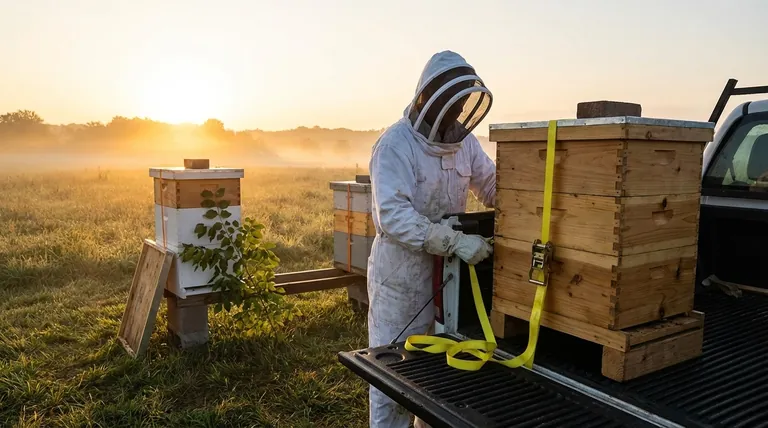
Phase 1: Pre-Move Preparation
Before the hive is ever lifted, the majority of the work is done. This phase is about setting the colony up for a safe and low-stress journey.
Timing the Move
The best time to move a hive is at night or in the very early pre-dawn hours. This ensures that all the foraging bees have returned to the hive for the day. Moving a hive mid-day will leave thousands of foragers stranded at the old location, severely weakening the colony.
Securing the Hive Components
A modern Langstroth hive is a stack of heavy boxes. These must be secured into a single, stable unit. Use ratchet straps that encircle the entire hive, from the bottom board to the outer cover. This prevents any components from shifting or separating during transit, which could crush bees or damage the comb.
Sealing the Entrance
Once all bees are inside after dark, the entrance must be blocked. You can use a dedicated moving screen or even simple foam or hardware cloth stuffed into the opening. The key is to ensure it's secure enough that agitated bees cannot escape during the move.
Phase 2: The Transport Process
The physical move is a moment of high risk for the colony. Your primary concerns are preventing overheating and physical shock.
Ensuring Proper Ventilation
This is the single most critical factor for bee survival during a move. A sealed hive full of tens of thousands of bees will rapidly generate a tremendous amount of heat. Without ventilation, they can literally cook themselves in a very short time. Use a screened bottom board or a screened inner cover to provide essential airflow.
Smooth and Steady Movement
When lifting and placing the hive, movements should be slow and deliberate. During transport in a vehicle, drive smoothly and avoid sudden stops or sharp turns. Jarring movements can cause frames of honeycomb to break, killing bees and potentially the queen.
Vehicle Placement
Place the hive in a truck bed or trailer so the frames are parallel to the direction of travel. This prevents the heavy, hanging frames from swinging like a pendulum, which can cause them to detach or crush the bees between them.
Understanding the Key Risk: The Homing Instinct
A honeybee's ability to navigate is remarkable, but it presents the greatest challenge for short-distance moves.
The "Two-Mile Rule"
Bees have a foraging and orientation range of roughly two to three miles. If you move a hive less than two miles, the older forager bees will emerge, orient to the sun, and fly directly back to the original hive location. Finding their home gone, they will cluster and perish, representing a significant loss to the colony's workforce.
The Problem with Short-Distance Moves
A move across the yard is biologically more complex than a move across the county. Because of their homing instinct, a short move requires a specific strategy to force the bees to re-evaluate their location and not simply return to the old spot.
Mitigating Forager Drift
For moves under two miles, you have two primary options:
- Move the hive more than two miles away for several weeks, then bring it back to the desired new location.
- Move the hive a few feet every day over a period of weeks until it reaches its destination. This is slow but effective.
Phase 3: Post-Move Reorientation
Your job isn't finished once the hive is in its new spot. You must actively help the colony understand that they have moved.
Immediate Placement and Opening
Place the hive in its final, permanent position before you unblock the entrance. Once you open the hive, you should not move it again. It's best to open the entrance early in the morning, allowing the bees a full day to explore and reorient.
Forcing a New Orientation
To prevent bees from leaving on "autopilot," place an obstruction directly in front of the entrance, like a leafy branch or a piece of plywood leaning against the hive. This forces them to stop, crawl around the object, and take note of their new surroundings. This simple trick triggers a new orientation flight, mapping the new location.
Monitoring and Support
Check on the hive a day or two after the move. Look for normal flight activity (bees coming and going with pollen). The move is stressful, so consider providing a 1:1 sugar water solution to give them an easy source of energy as they settle in.
Making the Right Relocation Choice
- If your primary focus is a long-distance move (over 2 miles): Your main goal is logistical safety—prioritize securing the hive components firmly and providing ample ventilation for the journey.
- If your primary focus is a short-distance move (under 2 miles): Your main goal is biological management—you must use a strategy like the "branch trick" or incremental daily moves to force the bees to remap their location.
- If your primary focus is colony survival above all: Never compromise on ventilation, move the hive during the coolest part of the day, and drive with exceptional care to prevent internal damage.
Ultimately, a successful hive move is a testament to a beekeeper's respect for the colony's complex biology and their commitment to careful, methodical work.
Summary Table:
| Relocation Phase | Key Beekeeper Actions | Primary Goal |
|---|---|---|
| Pre-Move Preparation | Time move for night/dawn; secure hive with straps; seal entrance. | Ensure all bees are contained and hive is stable for transit. |
| Transport Process | Ensure maximum ventilation; move smoothly; orient frames parallel to travel. | Prevent overheating and physical damage to the colony. |
| Post-Move Reorientation | Place obstruction at entrance; open hive in final position; monitor activity. | Force bees to remap location and prevent return to old site. |
Ensure your next hive relocation is a success with the right equipment from HONESTBEE.
For commercial apiaries and distributors, a smooth move is critical for colony health and productivity. Our wholesale-focused supplies—from durable ratchet straps and screened bottom boards for safe transport to essential feeding supplies for post-move support—are designed for professional beekeepers who demand reliability.
Let HONESTBEE equip your operation for safe, efficient, and stress-free hive relocations. Contact our wholesale team today to discuss your needs.
Visual Guide
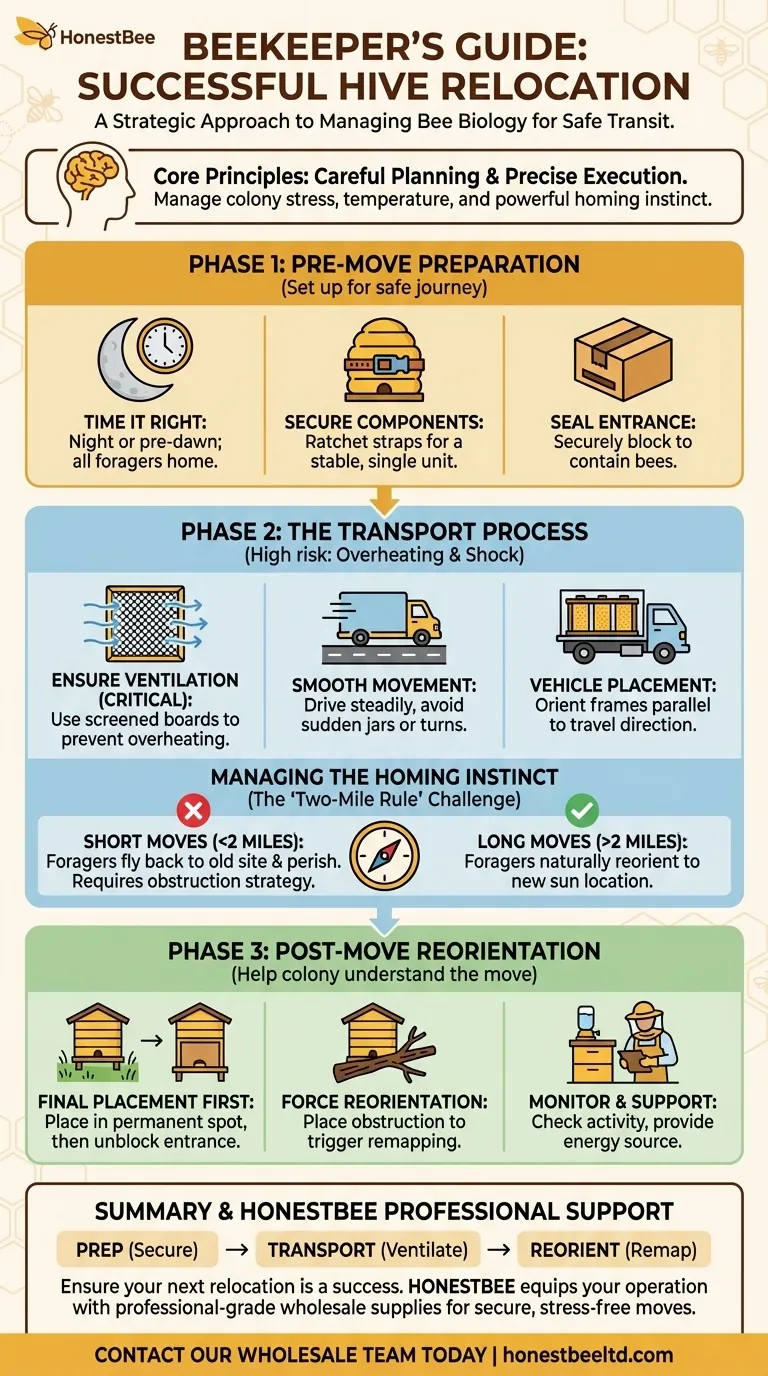
Related Products
- Endless Loop Ratchet Hive Strap
- Wholesales Dadant Size Wooden Bee Hives for Beekeeping
- HONESTBEE Classic Pry Bar Hive Tool with High Visibility Finish for Beekeeping
- Professional Grade Foldable Beehive Handles
- Premium Comfort Grip Spring-Loaded Hive Handles
People Also Ask
- What are the basic components of beekeeping equipment? Build a Thriving Hive from the Start
- How does climate influence the choice of hive for beekeepers? Optimize for Moisture & Temperature Control
- How do you loosen a ratchet strap? Master the 180-Degree Release for Easy Unloading
- What is the importance of understanding the function of each part of the beehive? Master Your Hive for a Thriving Colony
- What is the correct way to install a ratchet strap to reduce freezing in cold weather? Prevent Seizure with Proper Drainage


